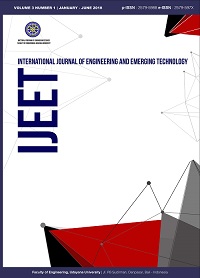Bed Bunk Accommodation; Convergence of Online Promotion Media with Balinese Traditional Houses in Canggu Village, Bali
Abstract
Bali is one of the most popular tourism destinations in the world with various forms of accommodation. Start from five star hotels until small lodgings built in each community residential unit. The strong custom and restrictions on tall buildings in Bali, making people look for various new alternatives to develop accommodation. The existence of local regulations that require the use of traditional Balinese ornamentation, requires accommodation owners to find adaptive accommodation development methods. However, with the development of the digital industry 4.0 specifically in contact with online advertising, there are no official rules in Bali that regulate it. This condition makes the demand for cheap accommodation in Bali seem unlimited. The promotion system no longer requires government legality. This phenomenon makes accommodations in remote places even can be accessed easily by all people in the world. The community then competes with each other to build cheap accommodations in their traditional homes. The government also cannot touch the spatial development caused by online media demand, due to the absence of regulations that limit it. This research tries to identify the bed bunk phenomenon that is built and operationalized through online promotion media, and has no legality. Data collection was carried out by direct observation of the object of study in Canggu village, district of North Kuta, Badung Regency, Bali Province. The findings of this study indicate that, bed bunk was born in Bali due to the high demand for backpacker tourists which is sufficient with wifi, table and bed facilities. The high cost of land in Bali encourages local people to build accommodations in their residential units. The maximum utilization of the interior (construction of 6-8 beds in one room) is the most preferred choice. This condition is due to vertical building restrictions that cannot exceed 15m and economic factors (get maximum income on narrow land). This finding is expected to be used as an evaluation material for spatial improvement in Bali which has an impact on congestion throughout the tourist area due to uncontrolled accommodation development.
Downloads
References
[2] Christina Gantini, J. P., Yuswadi Saliya, Dwinik Winawangsari. (2011). Traditional Balinese Architecture: What is Thought and What is Seen. Paper presented at the 1st Biennale ICIAP (International Conference on Indonesian Architecture and Planning).
[3] Creswell, J. W. (2014). Research Qualitative,Quantitative and Design. United State of America: SAGE Publication Inc.
[4] Dallen J.Timothy, V. B. T. (2009). Tourism and The Lodging Sector
(1st ed.). United State of America: ELSEVIER.
[5] Dwijendra, N. K. A. (2003). "Perumahan dan Permukiman Tradisional Bali." Permukiman "Natah" 01(01): 8-24.
[6] Fajar, A. (2011). Konvergensi Dalam Social (New) Media (Kajian Tradisi Kritis Sosial Budaya Terhadap Teoritisasi Komunikasi Antar Pribadi, Massa Dan Digital). Paper presented at the Seminar Nasional Teknologi Informasi & Komunikasi Terapan (SEMANTIK), Yogyakarta.
[7] Hory Gergely, Z. M., Peter Mullner,Melinda Benko. (2017). Exploration of Spatial Design Issues at Backpacker Hostels In Budapest's Historic Center: Informality, Density, Adaptability. Frontiers Of Architectural Research, 6, 157-168..
[8] Kiliçaslan, H. (2013). Design of Living Spaces in Dormitories. Procedia - Social and Behavioral Sciences. doi:10.1016/j.sbspro.2013.08.699
[9] Munyaradzi Mawere, T. R. M., Mirjan van Reisen,Gertjan van Stam. (2016). Maslow's Theory of Human Motivation and it's Deep Roots in Individualism: Interrogating Maslow's Applicability in Africa. Retrieved from https://www.researchgate.net/publication/302516151
[10] Moh.Wildan. (2014). The Symbolic Convergence of Cyberspace Communications. Jurnal Masyarakat Telematika dan Informasi, 5(2), 209-232.
[11] Ruonavaara, H. (2018). Theory of Housing, From Housing, About Housing. Housing Theory and Society, 35(2), 178-192. doi:10.1080/14036096.2017.1347103
[12] Sufyati. (2019). Konvergensi Media Dalam Religiusitas Masyarakat. Sosiologi Reflektif, 13(2).
[13] Sri Efrinita Irwan, T. M. (2019). A graph theory approach to the dormitory room placement problem. Journal of Science and Applicative Technology, 111-118. doi:https://doi.org/10.35472/281472.
[14] Suryadi, I. (2010). Teori Konvergensi Simbolik. Jurnal Academica Fisip Untad, 2(2).

 Indexed By
Indexed By







